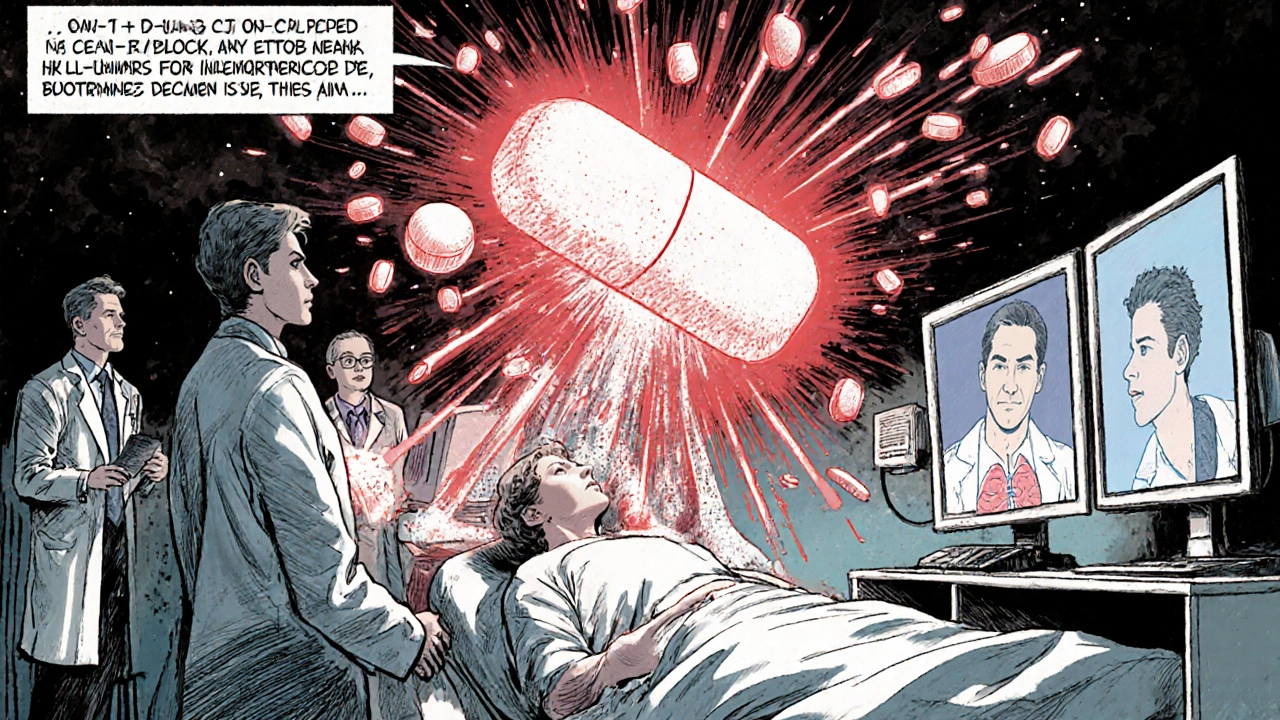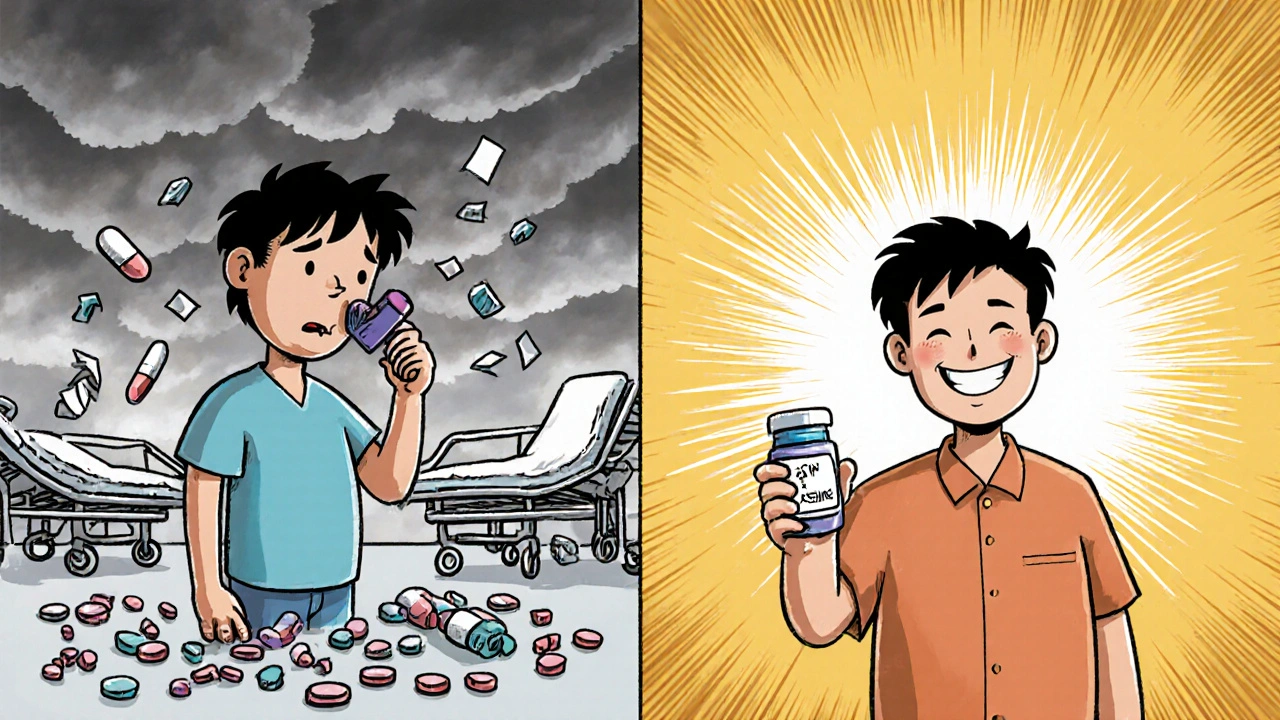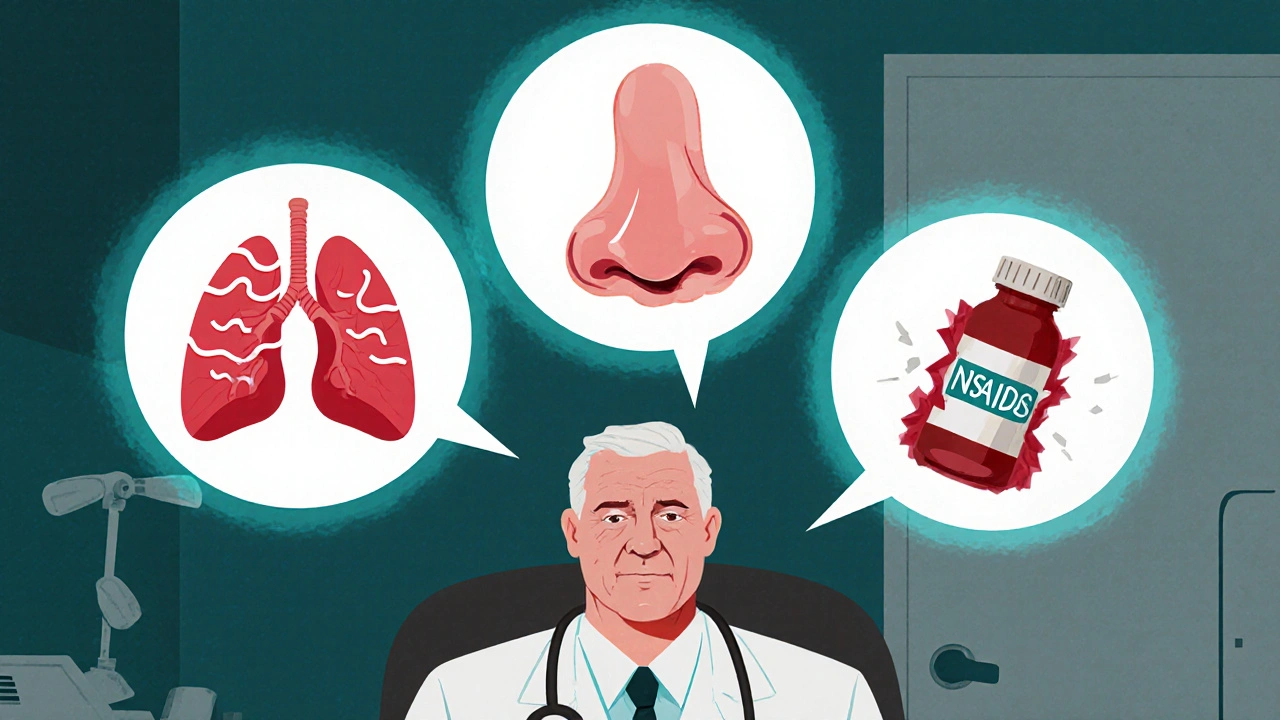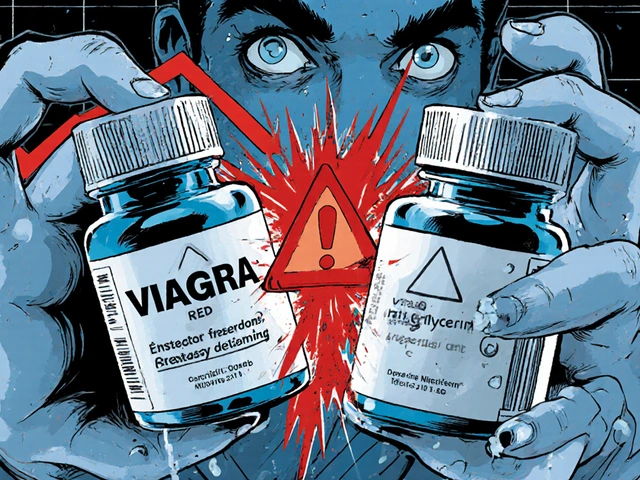What Is Aspirin-Exacerbated Respiratory Disease?
Aspirin-Exacerbated Respiratory Disease is a chronic condition where asthma, chronic nasal polyps, and sensitivity to aspirin and other NSAIDs occur together. It’s also called NSAID-ERD or Samter’s Triad, named after the doctor who first described it in the 1960s. Unlike allergies, this isn’t an immune reaction to the drug-it’s a biochemical imbalance triggered by blocking a specific enzyme, COX-1.
This condition doesn’t show up in childhood. It usually starts suddenly in adults between 20 and 50, often after years of mild asthma or sinus issues. People think they’re just getting worse allergies or sinus infections. But if you’ve had asthma since adulthood and keep getting nasal polyps that come back after surgery, this could be the real cause.
The Three Signs You Might Have AERD
If you have all three of these, you’re likely dealing with AERD:
- Chronic asthma that’s hard to control with standard inhalers
- Nasal polyps that grow back fast-often within a year after removal
- Severe reactions to aspirin, ibuprofen, naproxen, or other NSAIDs
Ninety-eight percent of people with AERD have constant nasal congestion. Over 90% lose part or all of their sense of smell. Many also get frequent sinus infections. The asthma symptoms-wheezing, chest tightness, coughing-tend to be worse than in other types of asthma. And unlike typical asthma, standard treatments like inhalers only help about 35% of AERD patients.
What Happens When You Take NSAIDs?
It’s not an allergic rash or hives. The reaction is internal, fast, and respiratory. Within 30 to 120 minutes after taking aspirin or ibuprofen, you might experience:
- Severe nasal blockage
- Frontal headache or sinus pressure
- Red, watery eyes
- Wheezing or trouble breathing
- Stomach upset, nausea, or vomiting
Ninety-two percent of reactions involve lower airway symptoms. This isn’t just a bad headache-it’s a full asthma attack triggered by a common painkiller. And it’s not just aspirin. Most NSAIDs that block COX-1 will do this. That includes over-the-counter drugs like Advil, Aleve, and generic ibuprofen.
Alcohol Can Trigger Symptoms Too
Many people don’t realize this, but about 75% of AERD patients react to alcohol-even a single glass of wine or beer. The reaction is similar: nasal congestion, coughing, or chest tightness. It’s not the alcohol itself. It’s how alcohol interacts with the same inflammatory pathway that NSAIDs trigger. This is often missed by doctors who focus only on medications. If you’ve noticed your asthma flares after drinking, that’s a big clue.

Why Standard Asthma Treatments Often Fail
Most asthma is managed with inhalers-corticosteroids and bronchodilators. But in AERD, the inflammation is driven by different chemicals: too many leukotrienes, not enough prostaglandin E2. These aren’t touched by standard inhalers. That’s why so many patients end up in the ER or hospitalized more often than others with asthma.
Studies show AERD patients visit the emergency room 2.3 times more often and are hospitalized 1.8 times more frequently than those with regular asthma. Nasal polyps grow back faster too-70% to 100% of the time within 18 months after surgery. That means repeated operations, lost workdays, and ongoing breathing problems.
The Big Miss: Underdiagnosis
Doctors miss this. A lot. The average patient waits 7 to 10 years before getting the right diagnosis. Why? Because most primary care providers and even some allergists aren’t trained to connect the dots between nasal polyps, adult-onset asthma, and NSAID reactions.
One patient on Reddit shared: “It took me 11 years and four ENT specialists before someone finally connected my asthma attacks after taking Advil to my nasal polyps.” That’s not rare. In fact, 31% of undiagnosed patients end up having unnecessary sinus surgeries because no one looked at the bigger picture.
There’s also a gap in care. Only 12% of allergy clinics in the U.S. offer aspirin desensitization-the most effective long-term treatment. Most patients are stuck managing symptoms with medications that don’t fix the root problem.
Aspirin Desensitization: The Game-Changer
There’s a treatment that can actually change the course of this disease: aspirin desensitization.
It sounds scary-you’re given increasing doses of aspirin under medical supervision until your body stops reacting. But it works. At centers like Brigham and Women’s Hospital and the University of Pennsylvania, success rates are above 90%. After completing the 2- to 3-day process, patients typically:
- Need fewer sinus surgeries (reduction of up to 60%)
- Have better asthma control (85% improvement)
- Experience slower polyp regrowth-from every 6 months to every 2-3 years
- Can safely take NSAIDs again
But here’s the catch: you have to take a daily low-dose aspirin (650 mg twice a day) forever. If you stop, the sensitivity comes back. It’s not a cure, but it’s the closest thing we have to halting the disease’s progression.
What About Biologics Like Dupixent?
Biologics are newer drugs that target specific parts of the immune system. Dupilumab (Dupixent) is FDA-approved for nasal polyps and has shown good results in AERD patients-reducing polyp size by 50-60%. But it’s expensive: about $38,500 a year. Only 38% of patients have insurance that covers it.
Many specialists now use biologics alongside or instead of aspirin desensitization, especially for patients who can’t tolerate daily aspirin. But biologics don’t restore NSAID tolerance. They only manage symptoms. Desensitization does both.

Who Should Get Tested?
You should consider testing if you:
- Have adult-onset asthma (started after age 20)
- Have recurring nasal polyps
- React to aspirin, ibuprofen, or alcohol
- Have lost your sense of smell
- Have had multiple sinus surgeries with quick recurrence
Testing usually involves a controlled aspirin challenge in a specialist’s office. It’s safe when done right. Many patients avoid it out of fear-but the risk of an uncontrolled reaction is far higher than the risk of a supervised test.
Where to Get Help
There are only about 35 specialized AERD centers in the U.S. Most are at major academic hospitals. If your doctor doesn’t know about this condition, ask for a referral to an allergist/immunologist who specializes in airway inflammation.
Resources like the Samter’s Society (a nonprofit patient group) offer free guides, videos, and provider directories. Their website has 127 detailed articles and 28 patient stories-something most clinics don’t provide.
Support quality matters. At top centers, you get 24/7 nurse access with responses under two hours. At general clinics, 63% of patients wait over 48 hours for a callback. Don’t settle for care that leaves you stranded.
What’s Next for AERD Treatment?
Research is moving fast. In 2023, the FDA gave breakthrough status to a new drug called MN-001, which blocks leukotrienes more effectively than older medications. Early trials showed a 70% drop in polyp regrowth.
A national registry is now tracking 2,000 AERD patients to better understand who responds to what treatment. The goal? Personalized therapy based on your specific immune profile.
By 2028, experts predict precision medicine will cut AERD-related surgeries by 40%. But until then, knowing your condition and seeking the right care is your best tool.
Final Thoughts
AERD isn’t just “bad asthma.” It’s a complex, misunderstood condition that affects breathing, smell, and quality of life. But it’s not hopeless. With the right diagnosis, you can take control. Aspirin desensitization isn’t for everyone-but for those who qualify, it’s life-changing.
If you’ve been struggling with asthma that won’t improve, polyps that keep coming back, or reactions to painkillers, don’t wait another year. Ask your doctor about AERD. You might be one appointment away from finally breathing easier.
Is aspirin-exacerbated respiratory disease the same as an allergy?
No, it’s not an allergy. Allergies involve IgE antibodies and typically cause hives, swelling, or anaphylaxis. AERD is a biochemical reaction caused by blocking the COX-1 enzyme, which leads to an imbalance in inflammatory chemicals. The symptoms look similar-wheezing, congestion-but the mechanism is completely different.
Can I take Tylenol (acetaminophen) if I have AERD?
Yes, acetaminophen (Tylenol) is generally safe for AERD patients because it doesn’t strongly inhibit COX-1. Most people can take it without triggering symptoms. However, some report mild reactions at high doses (over 1,000 mg at once), so start with a low dose and monitor your response. Always check with your specialist before using any new medication.
Do I need to avoid all NSAIDs forever?
If you haven’t had aspirin desensitization, yes-avoid all COX-1 inhibiting NSAIDs like ibuprofen, naproxen, diclofenac, and ketoprofen. Even topical NSAIDs (like gels or patches) can trigger reactions in some people. Acetaminophen and COX-2 inhibitors like celecoxib (Celebrex) are safer alternatives, but only under doctor supervision. After successful desensitization, you can safely take NSAIDs again.
Why do nasal polyps keep coming back in AERD?
In AERD, the immune system is stuck in a constant state of Type 2 inflammation, flooding the sinuses with eosinophils and inflammatory cytokines like IL-5 and IL-13. These cells cause tissue swelling and polyp growth. Surgery removes the polyps but doesn’t fix the underlying inflammation. Without targeted treatment like aspirin desensitization or biologics, polyps return quickly-often within months.
How long does aspirin desensitization take?
The process usually takes 2 to 3 days and requires hospitalization. You’re given gradually increasing doses of aspirin every 1.5 to 2 hours while being closely monitored. Most patients complete it within 48 hours. After that, you start daily low-dose aspirin (650 mg twice daily) and continue it for life. Skipping doses can cause sensitivity to return within days.
Can children get AERD?
No, AERD is almost never diagnosed in children. It’s an adult-onset condition, typically appearing between ages 20 and 50. If a child has asthma and nasal polyps, other conditions like cystic fibrosis or primary ciliary dyskinesia are more likely causes. AERD is not inherited, so having a parent with it doesn’t increase a child’s risk.
Is there a cure for AERD?
There’s no cure yet, but aspirin desensitization can stop the disease from progressing. It doesn’t eliminate the condition, but it restores normal immune balance in most patients. Many people report near-normal breathing, no more polyp surgeries, and the ability to take NSAIDs safely. Research into gene therapies and targeted biologics may one day lead to a cure, but for now, desensitization is the most effective long-term solution.
What should I do if I accidentally take an NSAID?
If you have a mild reaction-slight congestion or coughing-use your rescue inhaler and monitor your symptoms. If you develop wheezing, chest tightness, or trouble breathing, seek medical help immediately. Do not wait. Emergency treatment with nebulized bronchodilators and steroids can reverse the reaction. Always carry your inhaler and wear a medical alert bracelet stating "NSAID Sensitivity - AERD."



Scott Horvath on 27 October 2025, AT 13:58 PM
i had no idea alcohol could trigger this. been drinking wine for years and thought my asthma was just getting worse. turns out i’ve been poisoning myself with pinot noir. wow.